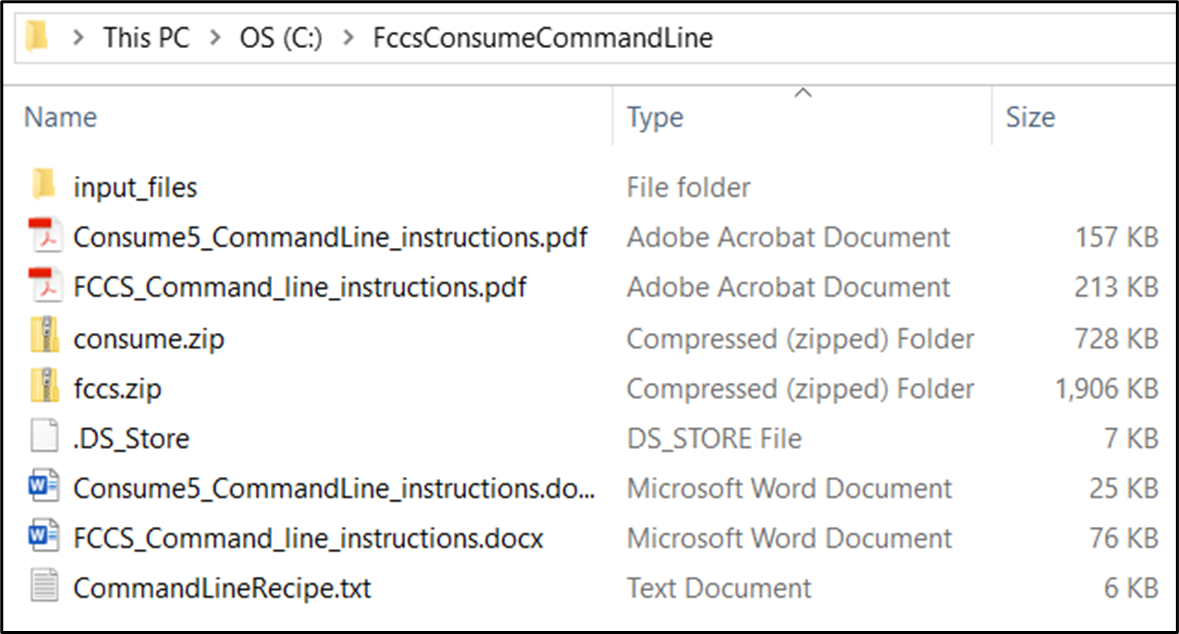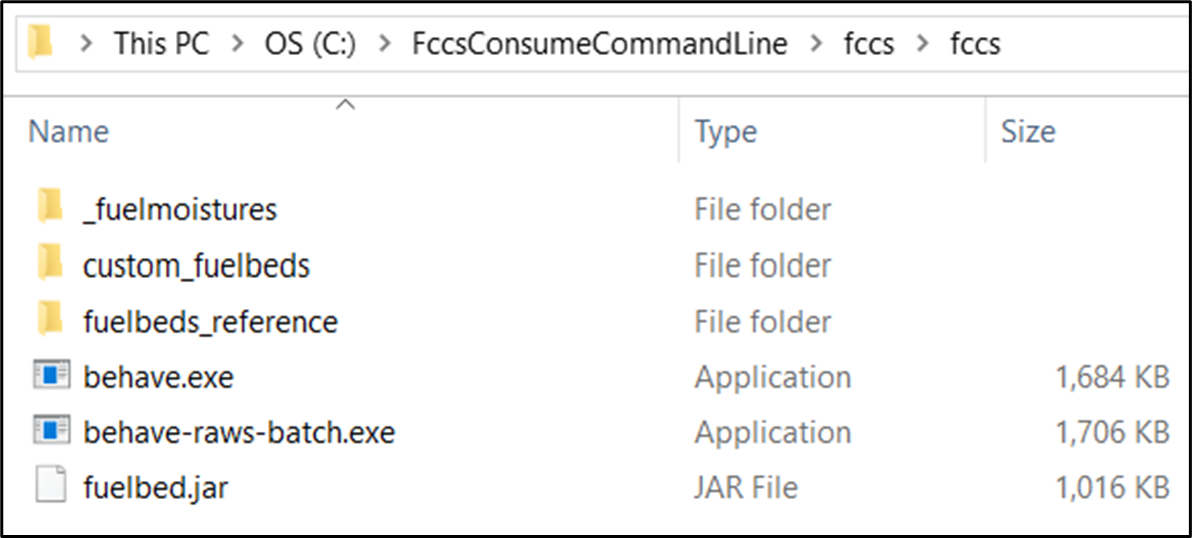Running FCCS & Consume From Command Line
You can run large sets of fuelbeds through the FCCS & Consume calculators by calling their executables from a command prompt.
Prerequisites: Java and Python installed with PATH environment variable updated
Start by downloading and unzipping the FccsConsumeCommandLine.zip file (unzipping to the C:\ drive in this example).

Contents of extracted FccsConsumeCommandLine.zip file
The command line instructions for each tool included in this package will be the most up-to-date and will supersede those given here where different. These instructions assume that Java and Python are installed with environment variables configured for command line use.
Running FCCS
- Set up your FCCS environment
- Unzip the fccs.zip file contained in the zip file.
- Add fuelbed .xml files to the fccs folder that contains the fuelbed.jar file. Copy your custom fuelbeds into their own folder and/or download and unzip FCCS fuelbed packages:
- FCCS Reference fuelbeds (base package of original 946 FCCS fuelbeds)
Download | File documentation
- FCCS Disturbance fuelbeds (~15K files)
Download | File documentation
- Region 6 pathway fuelbeds (487 files)
Download | File documentation
- Copy the sample fuel moisture file (sample_fccs_moisture.csv) from the input_files folder to the working fccs directory into newly-created ‘_fuelmoistures’ folder to use as a template for custom moisture scenarios. (Skip this step to accept the benchmark D2L2 moisture profile.)
FCCS fuel moisture inputs file data dictionary
This optional file contains a header followed by a single row of values that will apply to all fuelbeds in the given run.
| Column name |
Definition |
Example data |
| oneHourFM |
Fuel moisture % of 1-hr fuels (e.g., < 0.25” in diameter) |
6 |
| tenHourFM |
Fuel moisture % of 1-hr fuels (e.g., 0.25-1” in diameter) |
7 |
| hundredHourFM |
Fuel moisture % of 1-hr fuels (e.g., 1-3” in diameter) |
8 |
| liveNonWoodyFM |
Fuel moisture % of live forbs and graminoids |
60 |
| liveShrubFM |
Fuel moisture % of live shrubs |
90 |
| crownFM |
Fuel moisture % of live canopy |
90 |
The sample file is populated with the FCCS default/benchmark fuel moisture percents.
(D2L2 in the table below):
| FM Code |
FM Desc |
1,10,100,herb,shrub,crown |
| D1L1 |
Very low dead, fully cured herb |
3,4,5,30,60,60 |
| D1L2 |
Very low dead, 2/3 cured herb |
3,4,5,60,90,90 |
| D1L3 |
Very low dead, 1/3 cured herb |
3,4,5,90,120,120 |
| D1L4 |
Very low dead, fully green herb |
3,4,5,120,150,150 |
| D2L1 |
Low dead, fully cured herb |
6,7,8,30,60,60 |
| D2L2 |
Low dead, 2/3 cured herb |
6,7,8,60,90,60 |
| D2L3 |
Low dead, 1/3 cured herb |
6,7,8,90,120,60 |
| D2L4 |
Low dead, fully green herb |
6,7,8,120,150,90 |
| D3L1 |
Moderate dead, fully cured herb |
9,10,11,30,60,90 |
| D3L2 |
Moderate dead, 2/3 cured herb |
9,10,11,60,90,90 |
| D3L3 |
Moderate dead, 1/3 cured herb |
9,10,11,90,120,120 |
| D3L4 |
Moderate dead, fully green herb |
9,10,11,120,150,120 |
| D4L1 |
High dead, fully cured herb |
12,13,14,30,60,120 |
| D4L2 |
High dead, 2/3 cured herb |
12,13,14,60,90,150 |
| D4L3 |
High dead, 1/3 cured herb |
12,13,14,90,120,150 |
| D4L4 |
High dead, fully green herb |
12,13,14,120,150,150 |
Edit copies of this file to create custom fuel moisture scenarios. E.g., you could save the csv file with D1L1 values and name it 'D1L1.csv' to get outputs under drier conditions.
That file would look like:
oneHourFM,tenHourFM,hundredHourFM,liveNonWoodyFM,liveShrubFM,crownFM
3,4,5,30,60,60
- Assuming you downloaded the base (reference) fuelbeds package, your file structure will now look something like:

- Open a command prompt. In Windows, you can type “cmd” in the search box of the Start menu to open a command prompt.
- Change directories to the fccs folder that contains the fuelbed.jar file. In our example:
cd C:\FccsConsumeCommandLine\fccs\fccs
- Launch the calculator to get basic usage instructions.
java –jar fuelbed.jar
- To run FCCS for all fuelbeds within a folder (e.g., “custom_fuelbeds”) using benchmark fuel moistures, type:
java –jar fuelbed.jar custom_fuelbeds\*.xml
- To run FCCS for all fuelbeds within a folder (e.g., “custom_fuelbeds”) under a custom fuel moisture scenario, type (using our drier D1L1.csv):
java –jar fuelbed.jar custom_fuelbeds\*.xml –p moisture_file=D1L1.csv
- To convert the output file (fccs_summary.csv) to metric values, type:
python fccs_post_process.py fccs_summary.csv metric_all.csv metric_output.csv true
- For other commands, such as specifying an output filename and location or specifying wind or slope inputs, please refer to basic usage instructions within the command prompt.
Running Consume (building from above instructions)
The Consume 5 calculator module contains the consumption equations published in:
Prichard et al. 2017. Predicting forest floor and woody fuel consumption from prescribed burns in southern and western pine ecosystems of the United States. Forest Ecology and Management 405:328-338. The Consume source code was written in Python and can be cloned from GitHub repository https://github.com/pnwairfire/fera-apps-consume.
- Set up your Consume environment by unzipping the consume.zip file contained in the zip file.
- Open a command prompt and change into the consume working directory (the folder that contains the consume_batch.py file). In our example:
cd C:\FccsConsumeCommandLine\consume
- Consume requires python 3.10+. Check your python installation by typing:
python –version
If you get a ‘Python was not found’ message, you may either need to install (or reinstall) python, or add the executable to your computer’s PATH variable.
- Summary of commands to run Consume outside of FFT:
python -m venv my310env
source my310env/bin/activate
pip install -r requirements.txt
- To run the Consume python calculator, you must already have a loadings file (consume_loadings.csv). This is an FCCS output file that is generated whenever the FCCS calculator is run and is written to the same folder as the executable (fuelbed.jar) when you use the command line version of FCCS. It would probably be easiest to copy the consume_loadings.csv file to the consume working directory.
You are also required to specify the following arguments:
- Burn type (activity or natural)
Activity refers to a burn in recent logging slash and Natural refers to a burn in natural fuels that have not been influenced by recent logging or other disturbances (e.g., wind throw)
- Environmental inputs file (e.g., sample_consume_input.csv).
See data dictionaries for natural/activity input files below.
Note: each fuelbed has to have a corresponding input line.
- Consume loadings file (e.g., consume_loadings.csv file – an FCCS output) designated with the -f option.
Example command line entries:
python consume_batch.py natural sample_natural_input.csv –f consume_loadings.csv
python consume_batch.py activity sample_activity_input.csv –f consume_loadings.csv
Consume command line arguments:
| Variable
| Sample arguments
| Definitions
|
| Burn type |
activity
natural |
Activity refers to a burn in recent logging slash and Natural refers to a burn in natural fuels that have not been influenced by recent logging or other disturbances (e.g., wind throw) |
| Environmental inputs file |
input_western.csv, sample_activity_inputs.csv,
sample_natural_inputs.csv |
The environmental input file specifies environmental variables listed in the table below for each fuelbed listed in the fccs_loadings.csv file. |
| Consume loadings file |
-f fccs_loadings.csv |
Consume loadings by fuelbed stratum. This file is a standard output of FCCS calculations (either batch or within the FFT). |
Consume environmental inputs file data dictionary
This optional file should have the same number of records as the fccs_loadings.csv.
| Field |
Definition (units) |
Sample data |
| fuelbeds |
Fuelbed number in fccs_loadings.csv (one per row) |
220u1 |
| area |
Area (acres) |
1 |
| fm_duff |
Fuel moisture content of duff (%) |
40 |
| fm_1000hr |
Fuel moisture content of 1000-hr fuels (%) |
15 |
| can_con_pct |
Percent of canopy stratum blackened by fire (%) |
0 |
| shrub_black_pct |
Percent of shrub stratum blackened by fire (%) |
50 |
| pile_black_pct |
Percent consumption of piles (%) |
90 |
| units |
Tons or Mg/ha |
tons |
| ecoregion |
Region applicable to natural burn types (boreal, southern, or western) |
western |
| fm_litter |
Fuel moisture content of litter (%) |
10 |
| season |
Winter, spring, summer, or fall |
fall |
| duff_pct_available |
% duff available for consumption, 0-100% |
55 |
| sound_cwd_pct_available |
% sound coarse woody debris available for consumption, 0-100% |
55 |
| rotten_cwd_pct_available |
% rotten coarse woody debris available for consumption, 0-100% |
70 |
| Activity fuels only: |
| slope |
Slope gradient (%) |
0 |
| windspeed |
Windspeed (mph) |
4 |
| days_since_rain |
Number of days since significant rainfall (> ¼ inch) |
7 |
| length_of_ignition |
Time to ignite burn unit (min.) |
30 |
| fm_type |
Type of fuel moisture (MEAS-Th or NFDRS-Th) |
MEAS-Th |
| fm_10hr |
Fuel moisture of 10-hr wood |
10 |
Fuelbed generator spreadsheet tool
csvAndScript.zip April 1, 2025 (19KB)
.zip file includes an Excel spreadsheet template (fuelbedInputTemplate.xslx) and Python script (generateFuelbeds.py). generateFuelbeds.py will create fuelbeds based on fuelbedInputTemplate.xslx. (No validation support re fuelbed structure and values).

